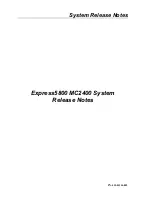
26
NOTE:
You can query the DIMM frequency and the maximum DIMM frequency supported by the CPU with
the
server-compatible part query tool
. In the query tool, query the DIMM frequency by the part name
of "memory module". Query the maximum DIMM frequency supported by the CPU by the part name
of "processor".
•
The operating frequency of DIMM in the server is equal to the lower of the DIMM frequency or
the maximum DIMM frequency supported by the CPU. For example, if the DIMM frequency is
2666 MHz and the maximum DIMM frequency supported by the CPU is 3200 MHz, then the
DIMM will run at 2666 MHz.
Guidelines for installing only DDR4 DIMMs
•
Make sure the corresponding CPU is installed.
•
DIMMs of different specifications (type, capacity, rank, data width, rate) cannot be mixed, that is,
all DIMMs installed on the server have the same product code. Query the product code
information with the
server-compatible part query tool
•
In addition to the above guidelines, different DIMM modes have their own specific guidelines,
as described in
. Note that when the actual DIMM installation does not meet these
specific guidelines, the system will use the default Independent mode regardless of the DIMM
mode configured by the user.
Table 21 Specific installation guidelines for different DIMM modes
Memory mode
DIMM population requirements
Independent Mode
(default)
•
Strictly follow the DIMM population schemes:
•
If one processor is present, see
•
If two processors are present, see
and
Mirror Mode
•
A minimum of two DIMMs for a processor.
•
This mode does not support DIMM population schemes that are not
recommended.
If one processor is present, see
If two processors are present, see
Memory Rank Sparing
•
Make sure no less than two ranks are configured for each channel.
•
Strictly follow the DIMM population schemes:
If one processor is present, see
If two processors are present, see
















































